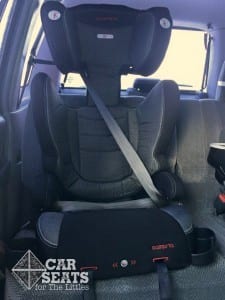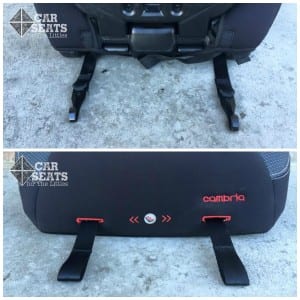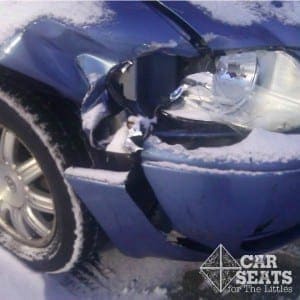When it comes to child passenger safety, the evolution of caregiver knowledge and state laws has been a slow process. However, more and more caregivers are learning that children need to ride in booster seats longer than they may have originally thought. As a child passenger safety technician, I’ve heard all the oppositions to proper booster use, and I’d like to provide some answers to those questions here. Hopefully, this myth busting guide will help keep your Little in a booster as long as it’s needed for them to be safe!
Myth #1: My child can move to a booster seat when they meet the height and weight requirements of the booster.

Meeting the height and weight limits of a booster, doesn’t make a child ready for one
FALSE! This Little meets the height and weight limits of this booster (30 pounds and 34 inches), but at only 3 years old, she’s not ready for a booster. For optimal safety, children should be at least 5 years old and are mature enough to sit properly at all times before they move from a harnessed car seat into a booster seat. Some caregivers start taking children on short drives in a booster around age 5 to practice using a booster before switching them full-time from a harnessed car seat. Many children will need to ride in a harnessed car seat until they are 6-7 years old.
Myth #2: My state law says my child can ride in a car without a booster seat at age 8, that must be safe.

State law says this Little is legal to go without a booster. The seat belt fit is very poor and would cause serious injuries in a crash.
FALSE! State laws vary a lot. There are states that allow children to ride without a booster seat as early as 5 years old and laws that require the use of some type of child restraint as late as 10 years old. Children need a booster until 10-12 years old and they pass the 5 Step Test. Children under 10 are not generally tall enough to ride safely without a booster and their bones are not strong enough to handle the crash forces put on them.
In our state, this Little is legal to ride without a booster at age six. Since she is not tall enough for her knees to naturally bend at the seat’s edge, she has slid forward to be more comfortable, thus making the seat belt fit even worse. The seat belt doesn’t fit her well at all and will cause damage to her internal organs in a crash. Just cross the state border and she’d need a booster until age 8. You can see how this can be confusing for parents, but if you follow best practice: leave the child in a booster until a height of 4’9″ in height and 10-12 years old, your child will be within the laws for all 50 states (and Canada).
Myth #3: My kid is too big for a booster seat.

The model used the Safety 1st Incognito until 11.5 years, 115 pounds, and 58 inches
FALSE! In most cases, even the biggest kids can still use a booster seat safely until they pass the 5 step test. There are plenty of seats available for big kids. Many have height limits of 60 inches and weight limits of up to 120 pounds
The oldest Little of the bunch (pictured here) used a booster, the Safety 1st Incognito, until he was 11.5 years old, weighed 115 pounds, and was 58 inches. At that point, he was tall enough to have the seat belt fit properly and his bones were mature enough to withstand crash forces.
Myth #4: A high back booster is safer than a backless booster.

This kiddo is 5.5 years old, weighs 40 pounds, and is 44 inches tall. She meets the requirements to use a booster, but might find a high back booster more comfortable.
Yes and no. High back boosters can be better at positioning the shoulder belt for smaller booster riders. Research shows a statistical safety advantage for high back boosters in side impact crashes, there is no statistical advantage to having a high back booster in the frontal crash tests at this time. However, we find that the high back can help remind booster riders to sit properly and the side impact protection added by the high back is also valuable.
Is your Child Ready for a Backless Booster Seat?
Here are some guidelines around deciding if your child is ready to move from the high back booster seat to a backless booster seat. If your child meets the following criteria:
- If the shoulder belt fits your child properly — across the center of their shoulder
- Can remain in position while sleeping in their booster seat
- Can sit properly in a backless booster
then they’re likely ready to move into a backless booster. We advocate for waiting as long as possible before making any change when it comes to car seats and booster seats.
Myth #5: If I use a high back booster, I don’t need a vehicle headrest behind it.

Some high back boosters require head supports behind them
FALSE! Though high back boosters are necessary for those vehicles with low seat backs, not all of them can be used without head support behind it. Some car seat manufacturers, such as Dorel and Diono (the Cambria high back booster is pictured here) require head support for their booster seats in both high back and backless mode. Be sure you always read your booster seat’s manual to know the specific rule for your seat.
Myth #6: I can’t use lower anchors with my booster seat.

The Diono Cambria uses hook on lower anchor connectors. Attach them to the lower anchors of the vehicle and tighten using the straps on the front of the seat.
FALSE! Many boosters come with lower anchor connectors now and consider that an added feature. Even many combination seats can continue to use lower anchors when they are switched to booster mode. The lower anchors eliminate the need to buckle in the booster when not in use so it does not become a projectile in a crash. Lower anchor weight limits also do not apply to boosters using lower anchors because the seat belt is doing the hard work of restraining the child in a crash. One other advantage of a booster seat with lower anchors: they hold the seat in place, making it easier for some children to buckle themselves in.
Myth #7: Booster seats do not need to be replaced after a crash

Many boosters require replacement even after minor crashes
FALSE! Unless the booster manufacturer follows NHTSA re-use guidelines, all seats should be replaced after a crash. Just like with harnessed seats, a crashed seat may not be able to adequately protect a child in a crash.
Myth #8: I’m a short adult, I must need a booster still
FALSE! Short adults still have adult bones. This means your iliac crest has formed and will do a better job at keeping your lap belt down on your pelvis, even if you aren’t the average 5’4″ adult woman. It’s important to always wear your seat belt properly, tight and low on the lap and across the shoulder; not behind your back or under your arm.
Around here we like to say, “when you know better, you can do better,” so hopefully this guide has given answers to any concerns you may have about how long to keep your older Little in a booster. Keep those Littles riding safely – in a booster as long as needed!
Originally written by Jennifer Penick. Edits lovingly maintained in her memory by CSFTL.
